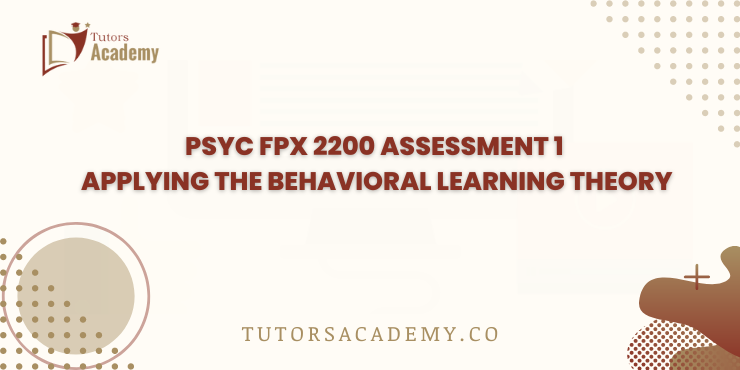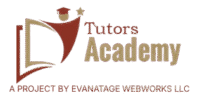
- PSYC FPX 2200 Assessment 1
Applying the Behavioral Learning Theory
Slide 1
Hello everyone, my name is Student and I will be your speaker for today’s topic, “Applying Behavioral Learning Theory in Education and Healthcare Today”. Henry is a new teacher in a middle school, and he applies the theoretical knowledge he has to make the students have an interest in the subject he teaches which is history. The behavioral learning theory will assist him in understanding the type of thinking skills that each student has so that he can assign them duties and reward them if they perform well.
Behaviorism also known as behavioral psychology is a theory that describes how people learn. It identifies that all behavior is acquired through transactions with the environment or what is known as training. Thus, behavior is not more than a reaction to what is going on in the environment. They can be examined in a very systematic and understandable manner. Behaviorism is concerned with observable behavior as a response to stimuli and has different aims.
Before it discusses the issues arising from the criticisms of behaviorism, most of which concern how it is misconceived and applied in teaching. Second, it is argued that behaviorism should only be practiced in an informed and moral manner if people know the theoretical background of the concept and the fact that it is a learning theory (Laeli, 2020).
Behavioral Learning Theory Perspective
Slide 2:
The theory that is associated with learning involves the behavior of persons is known as Behavioral learning theory or Behaviorism. Behaviorism is founded on the premise that all behavior is learned through the individual’s interaction with their environment. Also, events that occur in the world have more impact on behavior than do the natural tendencies that are inherited genetically.
Reinforcement is another form of behaviorism in the real world, and positive feedback is a good example. In the event that a child gets an A in the writing test, he or she is given a small gift. The next time around, students will strive to win the prize. Behaviorism is also useful for teachers because it has implications for students’ behavior in class and implies that teachers can influence students’ behavior.
According to Ryan and Deci (2020), teachers apply their thinking and leadership to assist students in overcoming challenges, cultivate positive interpersonal relationships with them, and boost their self-assurance in some aspects. To share this information with more coaches, we have to consider how behaviorism has evolved and how it has been received and modified. Because it takes into account actual behavior, the Behavioral approach may be in a position to accurately estimate the likelihood of a given behavior. This approach is supported by many other studies because it is rather not complicated to establish a stimulus-response environment in the course of an experiment (Niosi, 2021).
It is beneficial in numerous fields, such as operant conditioning and positive reinforcement applied in psychoanalysis, to capture people’s interest and to encourage them to work hard. Classical conditioning assists those who are frightened by various things to overcome their fears by making them think of other things that don’t frighten them when they are scared. Nevertheless, behaviorism claims that it is possible to eliminate undesired behaviors and offers ideas on the formation of habits. Cognitive scientists on the other hand do not look at learning as something that is external and that happens to us.
Some of the subjects that they cover include cognition such as thinking, knowing, reasoning, and being conscious (Mcleod, 2020). Those who support fundamentalism hold that such people should be taught how to ask questions and solve problems to learn via accessing and analyzing information. Since all that we do is learned, it is therefore possible to cultivate good habits. Behavioral theory which states that all of our complicated behavior is a result of our response to our environment supports the nurture side of the nature versus nurture debate (Hauser, n.d.).
Learning Task
Slide 3:
The present structure of the healthcare system in the US has assigned behavioral learning theory a significant role and acts on it. Nurses are also involved in the identification of strategies that can be used in enhancing the health status of the people and this involves coming up with better ways of teaching the people on the need to be healthy and fit. Nurses take behavioral learning theories into consideration of the cognitive skills of the individual and how the individual behaves when faced with a problem and its solution. In the community, the nurses apply the behavioral learning theory where people are taught how to quit vices, foster good relations, control their emotions, and act properly.
Behaviorism holds that teachers should manage the environment to obtain a particular objective. This is referred to as a teacher-centered approach to teaching (Sáiz-Manzanares et al., 2020). Most of the theories postulated about learning are employed in designing lessons that are taught in schools and exercises that are carried out in nurse training. It is, therefore, important for teachers to have some understanding of the theoretical framework of these theories so that they can apply it in different contexts.
Behaviorists believe that learning is when an object and an action communicate and alter a conspicuous action. Behavior learning theory also indicates that new nurses and nursing graduates should be informed of medical mistakes that should be avoided in order not to harm patients. This will assist them in being able to reason on how best they can avoid causing the patients any harm and also learn more about the patient’s rights. The way this method is applied is that one tries to observe how it impacts the learner’s emotional response (Fernandez et al., 2022).

Findings
Slide 4:
This study also reveals that the relationship between what teachers are motivated by and what students are motivated by is shifting. This is because rules, restrictions, and leadership ideas influence and bind teachers. There is a gap between the knowledge and the policy because most of the present Educational policies and practices that are in use today are built on a framework of motivation theories that are outdated and irrelevant for present-day learners and educators.
Research evidence has it that psychological need satisfaction is crucial in learning contexts (Ryan & Deci, 2020). First-year nursing students’ problems that make them stressed include stress which affects their performance, increases cases of illness, high turnovers, and missed classes. Peer and collaborative learning, directed study, problem and inquiry-based learning, experiential learning, reflection as well as learning by doing are the five modes of teaching and learning that have been found to support student resilience.
Flexibility is a key element in the nursing profession and it is beneficial to the health and well-being of the nurse him or herself. It is possible to enhance the adaptable traits and behaviors by enhancing the techniques of learning and training (Walsh et al., 2020).
Thus, to make the school function optimally the students and the graduates of the school must have the desire to become nurses. We do this because positive behaviors such as motivation are useful in teaching and learning contexts. This makes the children eager to learn hence they achieve their goals. Students should be encouraged to learn and this forms a very important aspect of good teaching (Filgona et al., 2020).
Application of Learning Task through Theory
Slide 5:
Organizational transformation, learning orientation, and creative work behaviors are related constructs. This therefore implies that healthcare professionals should have transformational leadership skills to get their staff to perform creative work. The healthcare system should try to build an organizational culture in which people are challenged to innovate, be stimulated to acquire new knowledge, and be allowed to apply it (Afsar & Umrani, 2019).
In the behaviorist approach, the students are encouraged by providing them with awards or praise points which may entail vocal encouragement. This is the same type of operant training that Skinner used to teach kids to behave, do their work or the like. Some of the theories of operant conditioning are employed by teachers to manage the entire school and assist children with disabilities. Behaviorism particularly Operant Conditioning Programmed Instruction has also been applied in teaching technology (Sage, n.d.).
Conclusion
Slide 6:
The factors that can alter the thinking of an individual in as much as to perform a given job or project are known as the behavioral learning theory. Every patient or a student will have their own perspective of the world and therefore the hospital staff and the teachers can bring out the best in the patient or the student by encouraging good behavior.
Explore our capella free samples by clicking below:
Capella free samples
References
Afsar, B., & Umrani, W. A. (2019). Transformational leadership and innovative work behavior. European Journal of Innovation Management, 23(3), 402–428.
https://doi.org/10.1108/ejim-12-2018-0257
Fernandez, R., Denham ‐Baloyi, W., Mathew, E., Secginli, S., Bahar, Z., Jans, C., Nahcivan, N., Torun, G., Lapkin, S., & Green, H. (2022). Predicting behavioral intentions towards medication safety among student and new graduate nurses across four countries. Journal of Clinical Nursing, 32(5-6).
https://doi.org/10.1111/jocn.16330
Filgona, J., Sakiyo, J., Gwany, D. M., & Okoronka, A. U. (2020). Motivation in Learning. Asian Journal of Education and Social Studies, 10(4), 16–37.
https://doi.org/10.9734/ajess/2020/v10i430273
Hauser, L. (n.d.). Behaviorism | Internet Encyclopedia of Philosophy. Internet Encyclopedia of Philosophy.
https://iep.utm.edu/behaviorism/
Laeli, A. F. (2020). Behaviorism: Psychological theory of learning. ELLITE: Journal of English Language, Literature, and Teaching, 5(2).
https://doi.org/10.32528/ellite.v5i2.3265
Mcleod, S. (2020). Cognitive Psychology. Simply Psychology.
https://www.simplypsychology.org/cognitive.html
Niosi, A. (2021). Behavioral learning theories. Opentextbc.ca.
https://opentextbc.ca/introconsumerbehaviour/chapter/behavioural-learning-theories/
Ryan, R. M., & Deci, E. L. (2020). Intrinsic and extrinsic motivation from a self-determination theory perspective: Definitions, theory, practices, and future directions. Contemporary Educational Psychology, 61(1), 1–11.
https://doi.org/10.1016/j.cedpsych.2020.101860
Sage. (n.d.). Module 18: Instruction: applying behavioral, cognitive, and constructivist approaches. Sagepublication.inc.
https://www.sagepub.com/sites/default/files/upm-binaries/79064_Module_18.pdf
Sáiz-Manzanares, M. C., Escolar-Llamazares, M.-C., & Arnaiz González, Á. (2020). Effectiveness of blended learning in nursing education. International Journal of Environmental Research and Public Health, 17(5), 1589.
https://doi.org/10.3390/ijerph17051589
Walsh, P., Owen, Patricia. A., Mustafa, N., & Beech, R. (2020). Learning and teaching approaches promoting resilience in student nurses: An integrated review of the literature. Nurse Education in Practice, 45(45), 102748.
